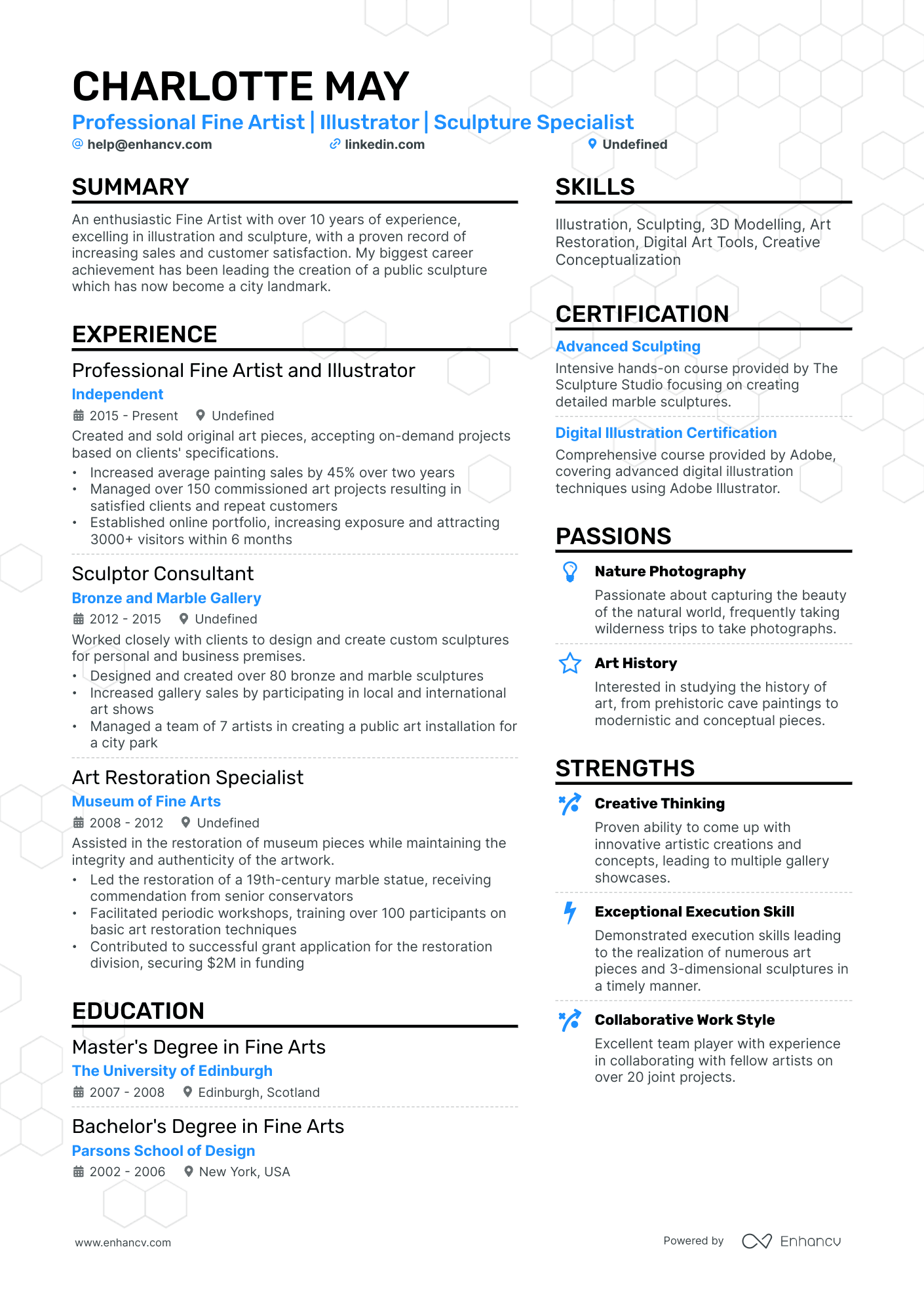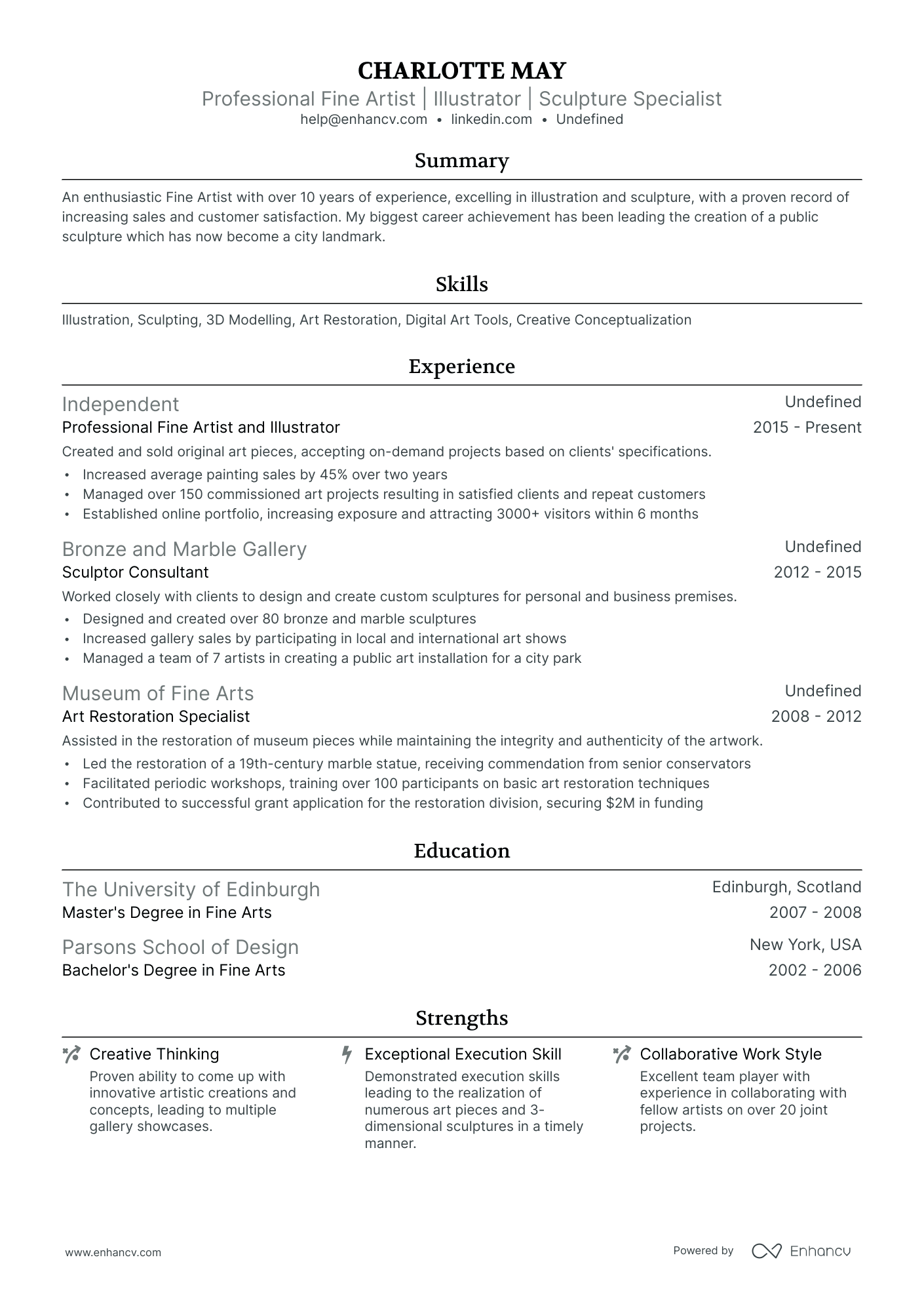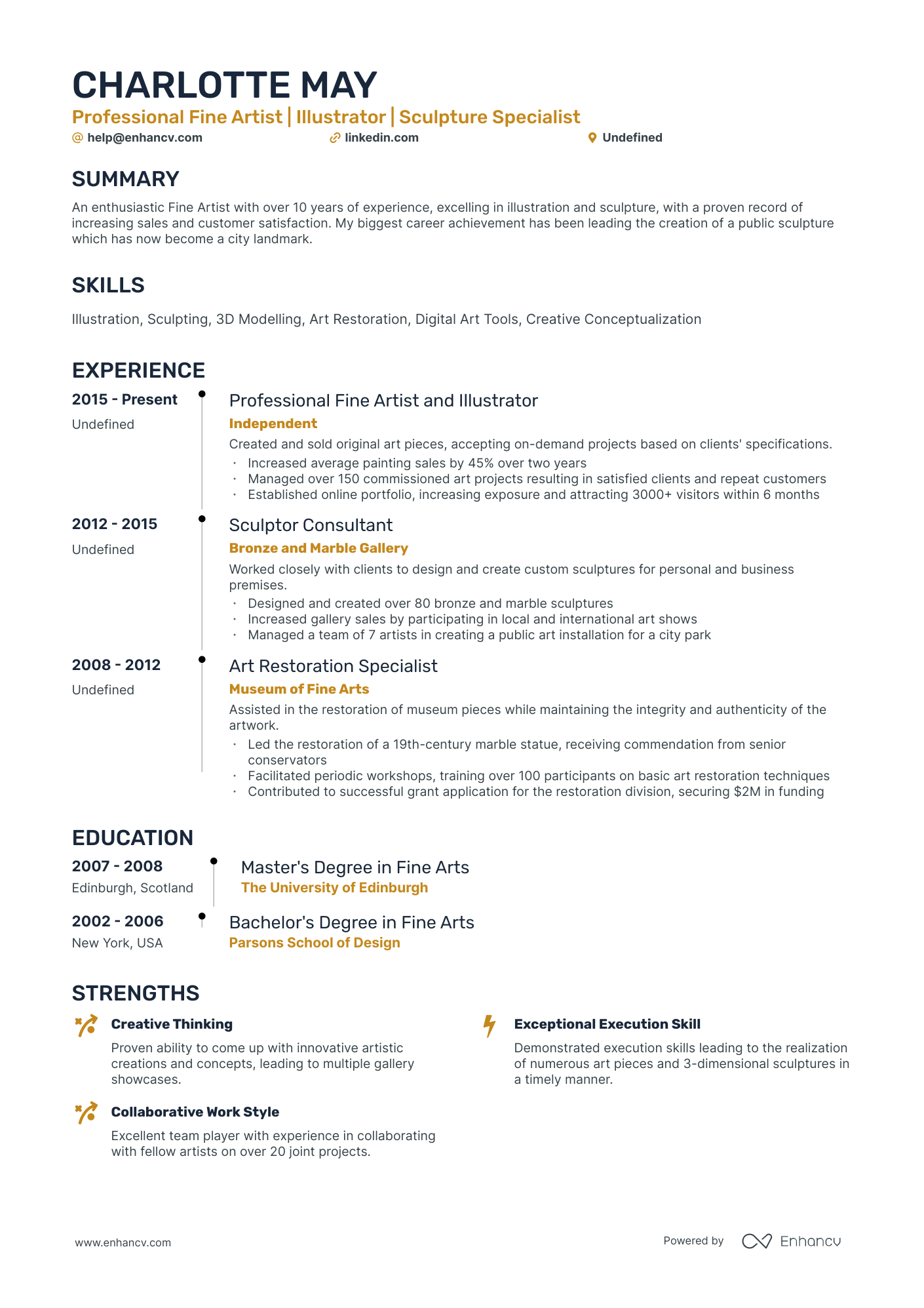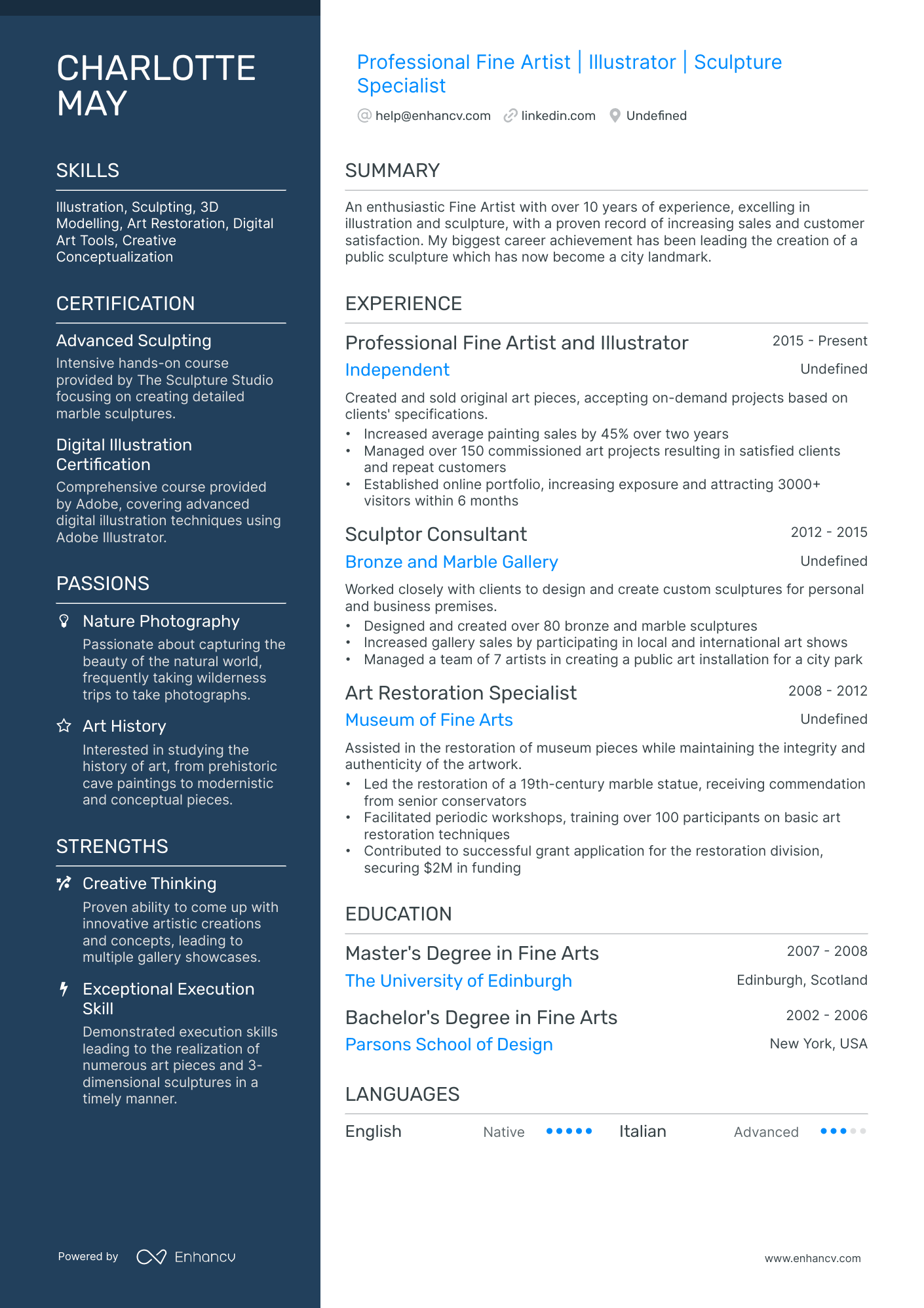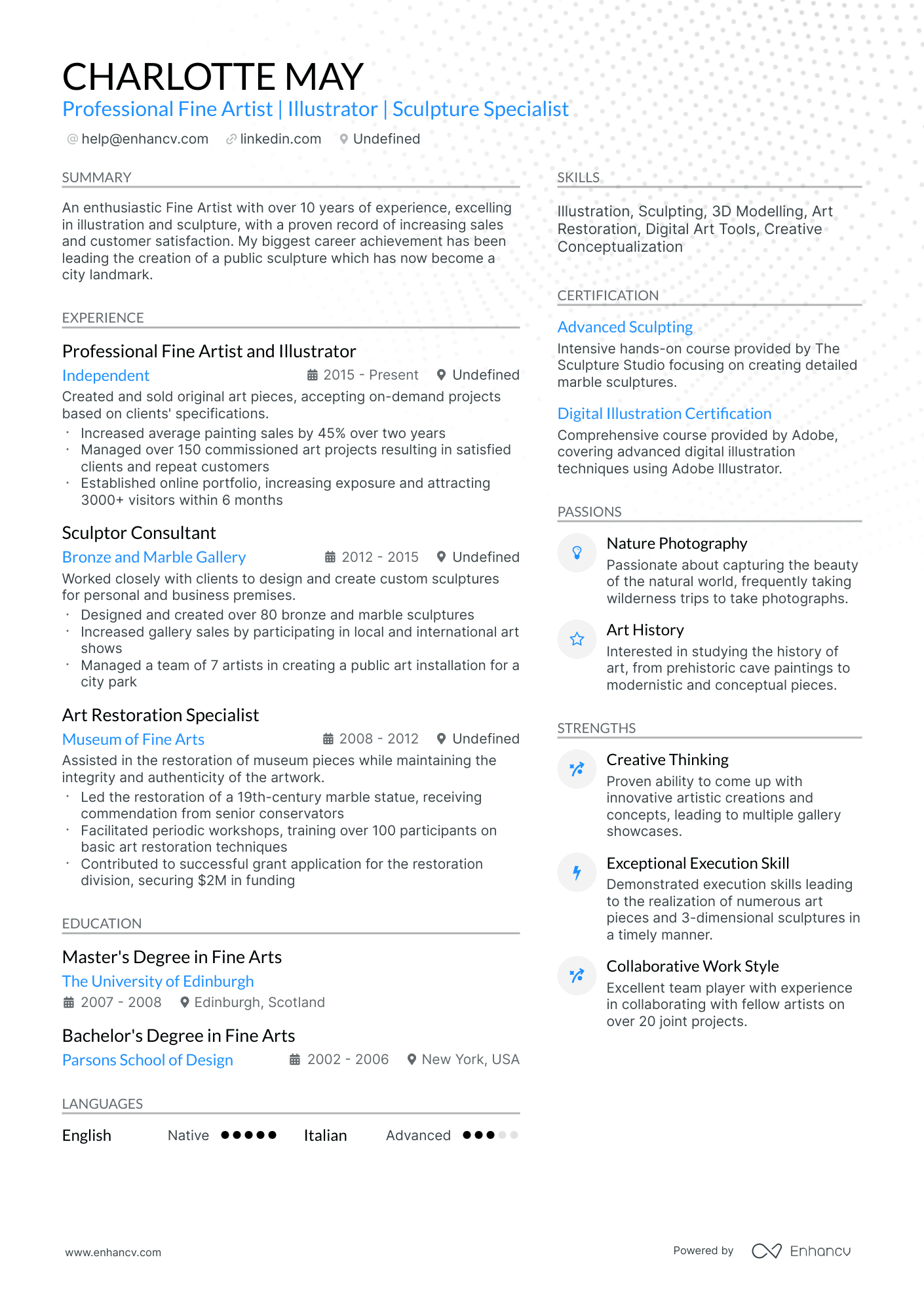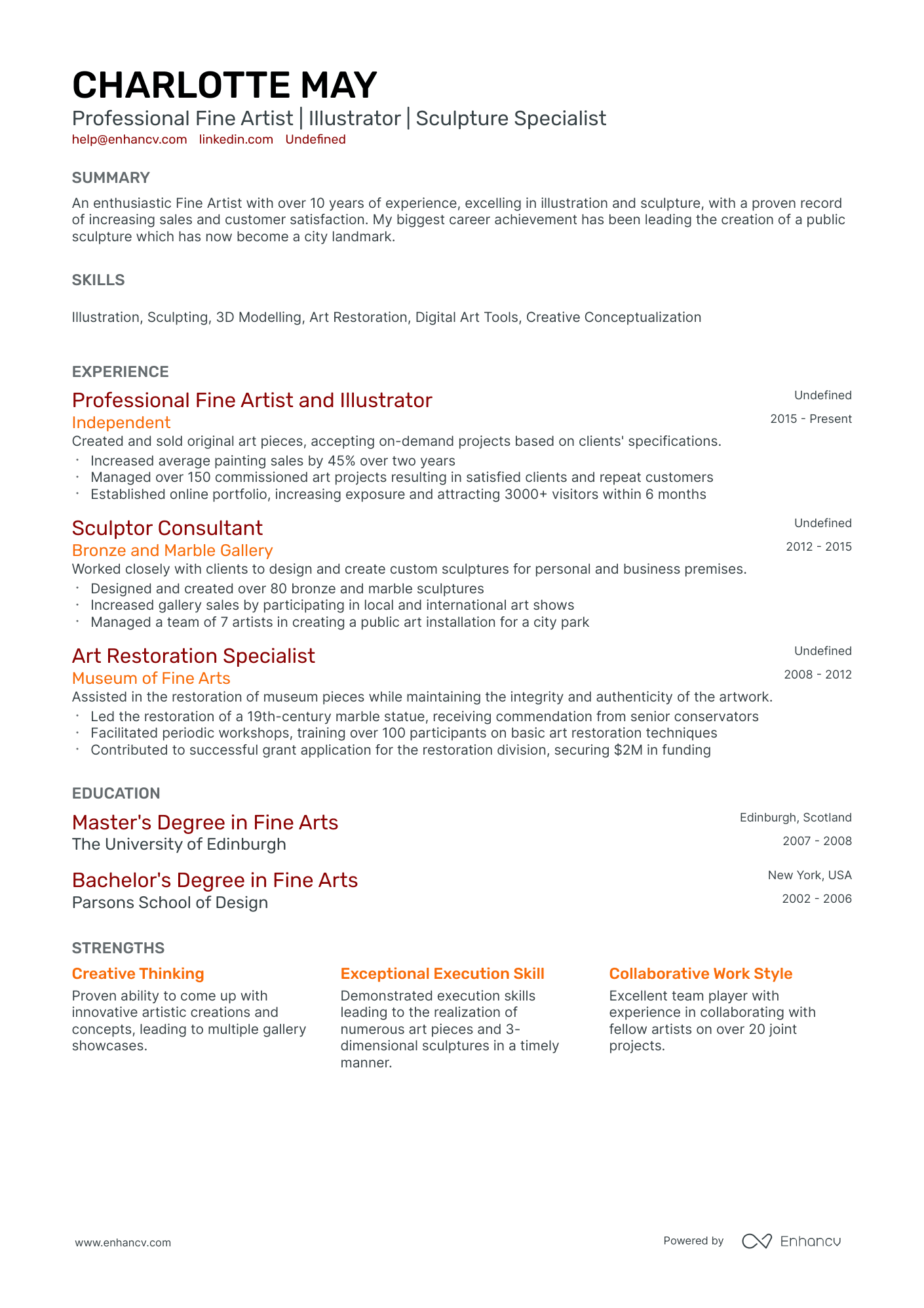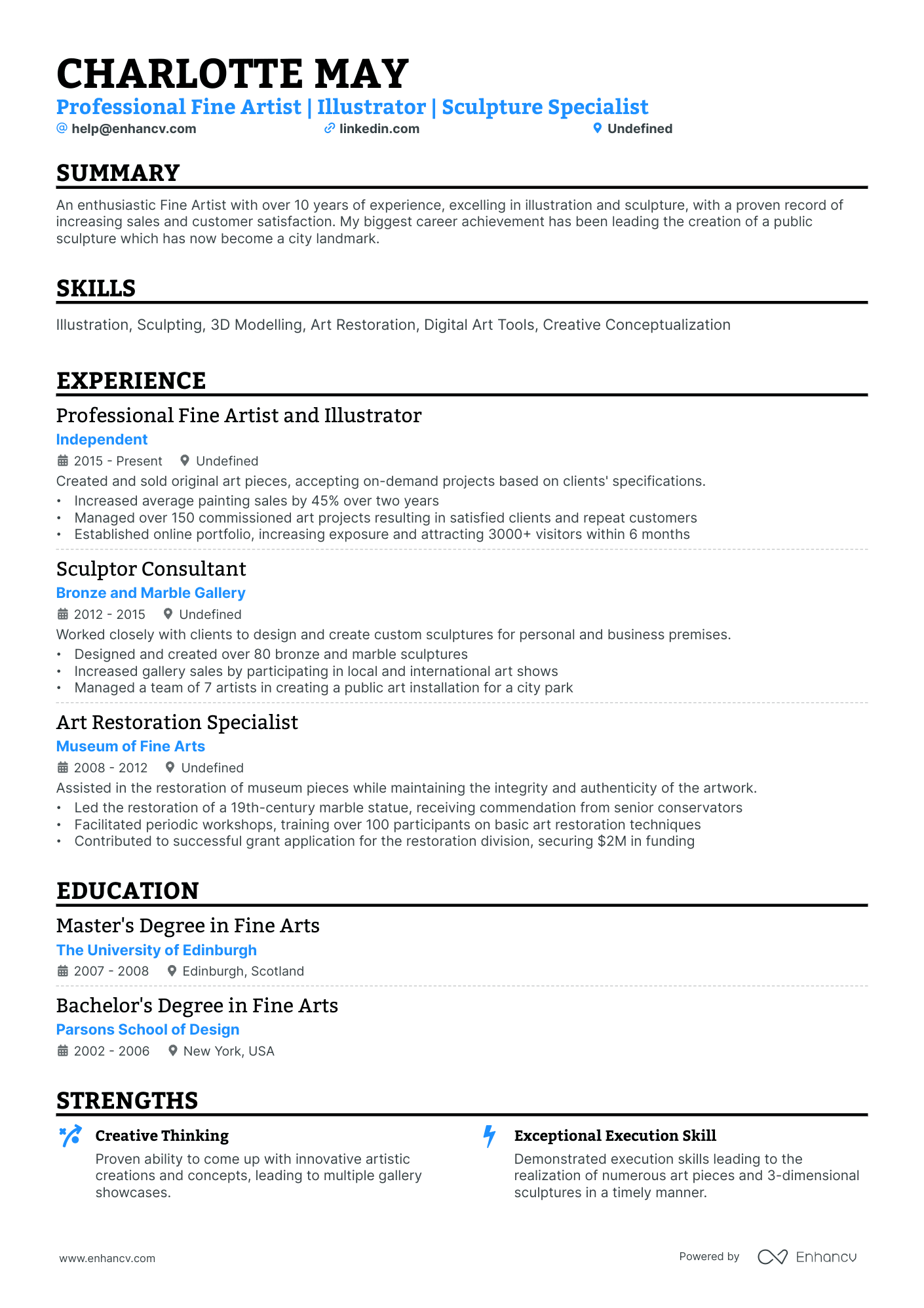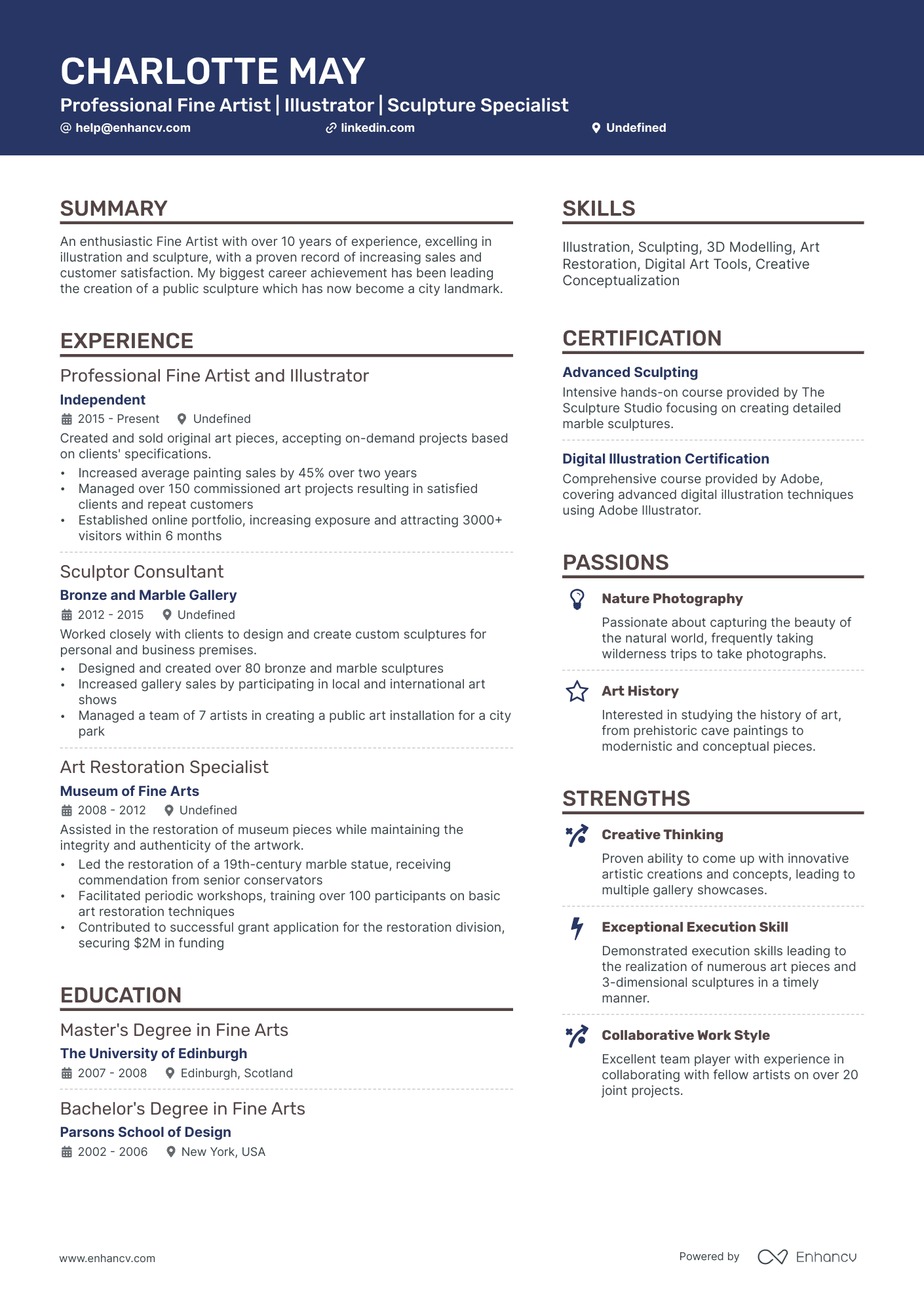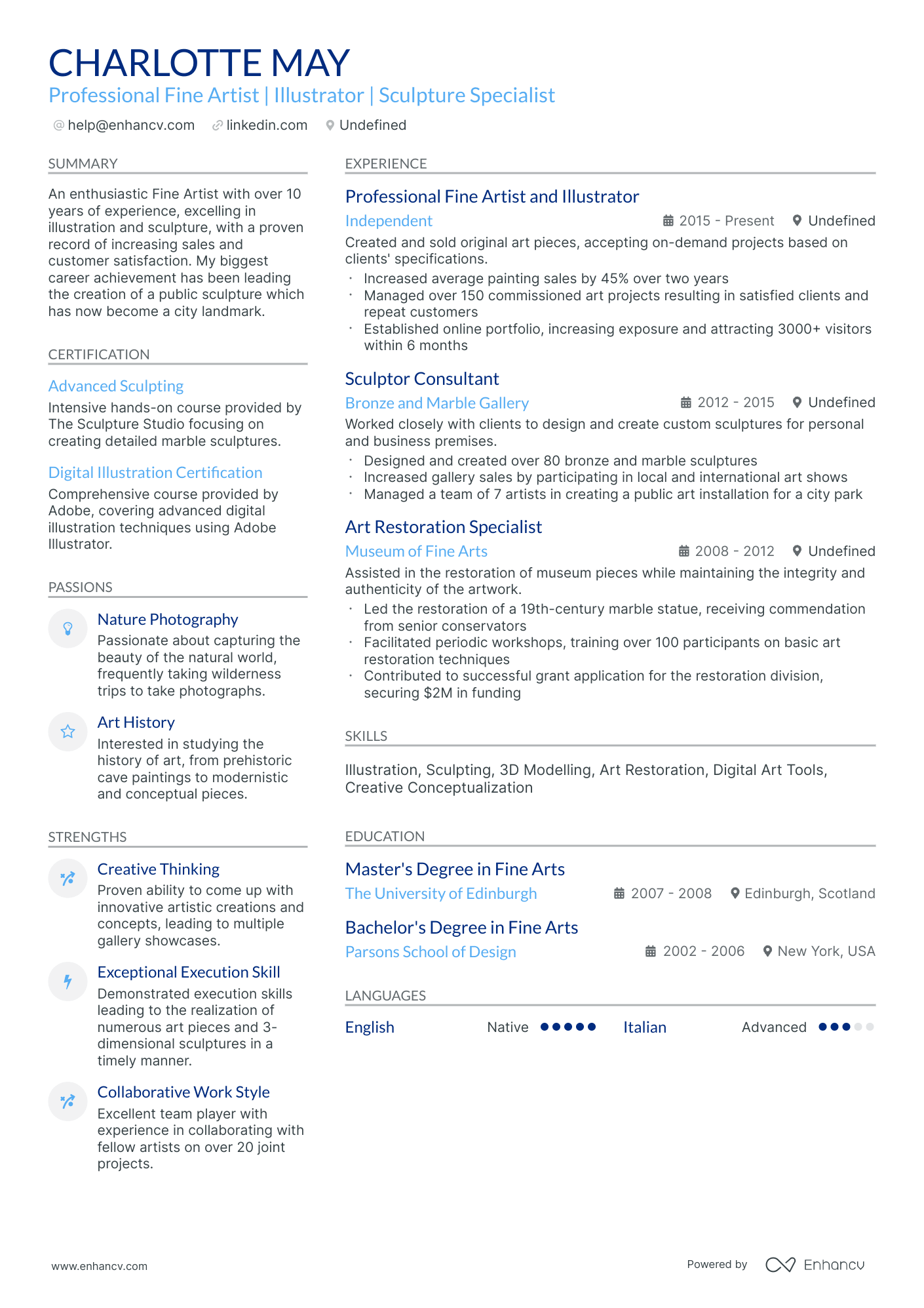Fine artists often struggle to articulate their unique creative process and portfolio of work in a resume format that is traditionally designed for more standard job experiences. Our guide can assist by providing specific strategies and examples for effectively communicating an artist's individual style and portfolio, showcasing them in a professional light while still maintaining their artistic individuality.
Dive into our comprehensive guide to crafting a standout fine artist resume:
- Discover fine artist resume samples that have secured positions at top-tier companies.
- Master the aesthetics of your resume layout for maximum impact.
- Strategically present your achievements and skills across various resume sections.
- Convey to recruiters why you're the perfect fit for the job.
Recommended reads:
Deciphering the best format for your fine artist resume
To craft an impactful fine artist resume, start by thoroughly analyzing the job description.
Your chosen resume format should seamlessly align your experience with the role's requirements.
Consider these four pivotal elements:
- Present your experience effectively. If you boast a wealth of pertinent experience, employ the reverse-chronological resume format, listing roles by date, beginning with the most recent.
- Maintain brevity. Limit your resume to a maximum of two pages, focusing on your most salient attributes.
- Headers serve a purpose. A well-crafted header ensures recruiters can swiftly access your contact details and professional portfolio.
- Opt for PDF. Typically, submit your fine artist resume in PDF to preserve its layout. However, always adhere to specific job application guidelines.
Upload your resume
Drop your resume here or choose a file. PDF & DOCX only. Max 2MB file size.
Pro tip
Choose a legible, professional font for your fine artist resume, such as Arial or Calibri.
Essential sections for your fine artist resume, favored by recruiters:
- A clear header with pertinent links and contact information.
- A concise summary or objective, offering a snapshot of your career milestones and your fit for the fine artist role.
- An experience section detailing your professional qualifications and achievements.
- Skills sections that align your talents with job-specific keywords and requirements.
- Education and certifications sections that underscore your dedication to industry-specific growth.
What recruiters want to see on your resume:
- Portfolio: A link or attachment to a strong portfolio showcasing a wide range of artistic skills and styles is crucial. It should demonstrate the artist's creative process, from conceptualization to final product.
- Artistic Skill Set: Specific artistic skills and techniques should be highlighted, such as painting, drawing, sculpting, digital art, etc. Any software proficiency like Adobe Creative Suite should also be mentioned.
- Educational Background: Although not always necessary, having formal education in fine arts or a related field can be beneficial. Include degrees, courses, workshops, or certifications you've obtained.
- Exhibition History: Artists who have displayed their work in galleries, art shows, or other public venues should include these experiences. This demonstrates exposure and recognition in the art community.
- Art Residencies, Grants, and Awards: These indicate an artist’s professional success and acceptance within the art world. They show that the artist has been vetted and recognized by reputable organizations or entities.
Recommended reads:
Designing your fine artist resume experience to grab recruiters' attention
For the fine artist position, it's crucial to show how your expertise matches what they're looking for.
Your resume experience section can be a game-changer. Ensure you:
- Feature roles most relevant to the fine artist job you're targeting.
- Avoid diving too deep into ancient history - unless what you did a decade ago is super relevant to the fine artist role.
- Structure each bullet to first describe what you did, followed by the skills you utilized, and then the impact of your efforts.
- Quantify your achievements with numbers, possibly highlighting the broader impact on the organization.
- Emphasize transferable skills - those you've gained in past roles that could be valuable in your new role. This showcases your unique professional value.
Crafting the experience section doesn't mean detailing every job you've ever had. Check out the fine artist resume samples below to see how top professionals present their experience.
- Collaborated with a team of artists to create large-scale murals for public spaces, resulting in increased community engagement and positive feedback.
- Developed and executed a series of solo exhibitions showcasing mixed media artwork, attracting over 500 visitors and generating $10,000 in sales.
- Utilized various artistic techniques, including oil painting and sculpture, to create visually captivating pieces that conveyed complex emotions and themes.
- Partnered with local galleries to organize group art shows featuring emerging artists, resulting in increased exposure for all participants and fostering a vibrant artistic community.
- Implemented innovative marketing strategies, including social media campaigns and email newsletters, to promote art events and reach a wider audience.
- Received commissions from private collectors and businesses to create customized artwork, meeting strict deadlines and exceeding clients' expectations.
- Collaborated with interior designers to create unique art installations for luxury hotels and upscale residences, enhancing the visual appeal of the spaces and contributing to a memorable guest experience.
- Participated in art fairs and exhibitions, securing contracts with renowned galleries and expanding the network of potential buyers and collectors.
- Utilized digital tools and software, such as Adobe Photoshop and Illustrator, to create digital art pieces exploring the intersection of technology and traditional art forms.
- Collaborated with a team of illustrators to create illustrations for a children's book series, resulting in visually captivating imagery that brought the stories to life and contributed to increased book sales.
- Provided art direction and guidance to junior artists, fostering their professional growth and ensuring adherence to project timelines and quality standards.
- Participated in art competitions and juried shows, winning multiple awards for artistic excellence and gaining recognition from renowned art critics.
- Created vibrant and imaginative artwork for an indie video game, collaborating closely with game developers and incorporating feedback to ensure visual cohesion with the game's narrative.
- Organized and led art workshops for aspiring artists, sharing techniques and insights to inspire creativity and foster a passion for art among attendees.
- Participated in community art projects, such as public installations and collaborative murals, promoting art accessibility and cultural enrichment.
- Developing a series of interactive digital art installations using cutting-edge technologies like virtual reality and augmented reality, exploring the convergence of art and technology.
- Collaborating with programmers and software engineers to incorporate interactive elements into art installations, creating immersive and engaging experiences for viewers.
- Participating in international art residencies, working alongside artists from diverse backgrounds and cultures, fostering cross-cultural exchange and artistic exploration.
- Created a series of large-scale sculptures using unconventional materials, pushing the boundaries of traditional sculpture and exploring new forms of artistic expression.
- Collaborated with architects to integrate sculptures into building designs, resulting in visually striking architectural elements that enhanced the overall aesthetic and atmosphere of public spaces.
- Received grants and funding from arts organizations and foundations, supporting the creation of ambitious sculptural projects and facilitating their public display.
- Curated and organized art exhibitions featuring emerging and established artists, creating cohesive and thought-provoking displays that showcased a wide range of artistic styles and perspectives.
- Managed gallery operations, including artwork selection, marketing campaigns, and client relations, resulting in increased sales revenue and positive feedback from artists and collectors.
- Developed and maintained relationships with art collectors, providing consultation services and assisting in the acquisition of artworks, resulting in successful sales and repeat business.
- Collaborated with fashion designers to create unique textile prints and patterns, combining traditional art techniques with digital tools to develop visually striking and marketable designs.
- Participated in international art festivals and exhibitions, showcasing textile artwork that pushed the boundaries of conventional fabric art and exploring new avenues of creativity.
- Worked closely with manufacturers to ensure the accurate reproduction of textile designs, maintaining quality standards and delivering exceptional products to clients.
- Collaborated with architects and interior designers to create site-specific installations for corporate offices, hotels, and public spaces, transforming environments and adding a unique artistic touch.
- Managed multiple art projects simultaneously, overseeing budgets, timelines, and subcontractors, resulting in successful project completion and client satisfaction.
- Implemented sustainable art practices by repurposing materials and utilizing eco-friendly techniques, aligning artistic vision with environmental responsibility.
The following content includes information from "O*NET OnLine" by the U.S. Department of Labor, Employment and Training Administration (USDOL/ETA). Used under the CC BY 4.0 license. The data represents the top responsibilities present on the task lists for fine artist professionals.
Top Responsibilities for Fine Artist:
- Integrate and develop visual elements, such as line, space, mass, color, and perspective, to produce desired effects, such as the illustration of ideas, emotions, or moods.
- Confer with clients, editors, writers, art directors, and other interested parties regarding the nature and content of artwork to be produced.
- Maintain portfolios of artistic work to demonstrate styles, interests, and abilities.
- Market artwork through brochures, mailings, or Web sites.
- Study different techniques to learn how to apply them to artistic endeavors.
- Monitor events, trends, and other circumstances, research specific subject areas, attend art exhibitions, and read art publications to develop ideas and keep current on art world activities.
- Photograph objects, places, or scenes for reference material.
- Model substances such as clay or wax, using fingers and small hand tools to form objects.
- Create sculptures, statues, and other three-dimensional artwork by using abrasives and tools to shape, carve, and fabricate materials such as clay, stone, wood, or metal.
- Set up exhibitions of artwork for display or sale.
Quantifying impact on your resume
<ul>
Writing your fine artist experience section without any real-world experience
Professionals, lacking experience, here's how to kick-start your fine artist career:
- Substitute experience with relevant knowledge and skills, vital for the fine artist role
- Highlight any relevant certifications and education - to showcase that you have the relevant technical training for the job
- Definitely include a professional portfolio of your work so far that could include university projects or ones you've done in your free time
- Have a big focus on your transferable skills to answer what further value you'd bring about as a candidate for the fine artist job
- Include an objective to highlight how you see your professional growth, as part of the company
Recommended reads:
Pro tip
Boost your resume by focusing on the practical aspects of each job requirement. While it's good to have job-related keywords on your resume, ensure they're backed by action verbs and quantifiable data. This gives recruiters a clear picture of your fine artist professional journey.
Highlighting essential hard and soft skills for your fine artist resume
Your skill set is a cornerstone of your fine artist resume.
Recruiters keenly evaluate:
- Your hard skills, gauging your proficiency with specific tools and technologies.
- Your soft skills, assessing your interpersonal abilities and adaptability.
A well-rounded candidate showcases a harmonious blend of both hard and soft skills, especially in a dedicated skills section.
When crafting your fine artist skills section:
- List up to six skills that resonate with the job requirements and highlight your expertise.
- Feature a soft skill that encapsulates your professional persona, drawing from past feedback or personal reflections.
- Consider organizing your skills into distinct categories, such as "Technical Skills" or "Soft Skills."
- If you possess pivotal industry certifications, spotlight them within this section.
Crafting a comprehensive skills section can be daunting. To assist, we've curated lists of both hard and soft skills to streamline your resume-building process.
Top skills for your fine artist resume:
Oil Painting
Acrylic Painting
Watercolor Techniques
Drawing and Sketching
Digital Illustration
Sculpture Techniques
Mixed Media Art
Printmaking
Photography
Art Software (e.g., Adobe Creative Suite)
Creativity
Attention to Detail
Time Management
Communication
Adaptability
Critical Thinking
Problem-Solving
Collaboration
Self-Motivation
Emotional Intelligence
Next, you will find information on the top technologies for fine artist professonals from "O*NET OnLine" by the U.S. Department of Labor, Employment and Training Administration (USDOL/ETA). Used under the CC BY 4.0 license.
Top technologies for Fine Artist’s resume:
- Adobe Creative Cloud software
- Adobe Photoshop
- GroupMe
- Autodesk AutoCAD
- Trimble SketchUp Pro
Pro tip
The placement of your skills section should align with its importance. If it's a showcase of your most significant strengths, position it prominently near the top of your resume.
Highlighting fine artist-specific certifications and education
Your resume education section can be a treasure trove of skills and experiences relevant to the role. Here are the best practices when it comes to featuring it on your resume:
- Highlight advanced qualifications, detailing the institution and duration.
- If you're currently pursuing a degree, mention your expected graduation date.
- Consider omitting unrelated degrees.
- If your academic journey boasts significant achievements, especially in research, elaborate on them.
What's more, shocasing relevant industry certifications can bolster your credibility, even if you lack extensive work experience.
To effectively present your certifications:
- Place pivotal industry certifications prominently in a dedicated section.
- If a certification is particularly impressive, consider featuring it near your name or within the header, summary, or objective.
- Provide details, where relevant, to underscore alignment with the role.
- Recent certifications should be given advantage, as they show your up-to-date knowledge.
Both education and certification sections highlight your commitment to professional growth, a trait valued by employers. Below, explore some of the most current and sought-after fine artist certifications to enhance your application:
Best certifications to list on your resume
Pro tip
List your degrees in reverse order, starting with the newest. A recent PhD or unique field could set you apart.
Recommended reads:
Choosing between a resume summary or objective
Many fine artist candidates ponder whether to include a resume summary or objective.
Here's a breakdown:
- A Resume objective outlines your career aspirations. It tells recruiters why you're applying and the value you can bring.
- A Resume summary offers a snapshot of your significant achievements, giving a quick overview of your expertise.
New professionals might lean towards an objective, while seasoned experts might prefer a summary. Whichever you choose, ensure it's tailored to the role.
For inspiration, review examples from established fine artist professionals.
Resume summary and objective examples for a fine artist resume
-
Boasting 10 years of experience as a fine artist specializing in watercolor and oil painting, the applicant has developed an esteemed reputation for extraordinary attention to detail and creative innovation. Skilled in conceptual visual development, they have held four successful gallery exhibitions and received the National Arts Award in 2022.
-
With seven years' practical experience as a freelance Sculptor, the individual brings a unique perspective to the fine arts world. Equipped with excellent spatial understanding and complex problem-solving skills, they are known for their avant-garde marble sculptures that challenge traditional themes and forms. The artist's illustrious career includes a solo exhibition at a renowned international art festival.
-
An experienced Graphic Designer with a decade-long career, seeking to transition into the fine arts sector. Proficient in digital media, the artist aims to blend their design acumen with traditional painting techniques. Their proudest achievement is leading a team to win the prestigious Digital Design Award in 2021.
-
A Creative Director from the advertising industry aiming to shift focus towards fine arts. With over 15 years of experience in creative strategy and design, this person brings an unmatched understanding of color theory and composition. Notably, they directed an international campaign which won multiple accolity in global ad festivals.
-
Entry-level professional with a genuine passion for fine arts desires to hone their craft within a reputable institution. Holding a Bachelor's degree in Visual Arts, they aim to explore diverse artistic styles while pushing boundaries through contemporary expression. Their objective is to contribute meaningfully to the company’s artistic endeavors while growing as an artist.
-
A recent Fine Arts graduate aspires to embark on a career path where creativity meets innovation. Keen to apply acquired knowledge of various mediums and techniques, they aim to develop a distinctive artistic voice. Their objective centers around creating impactful art which resonates with audiences and inspires dialogue within the company and beyond.
Additional sections to elevate your fine artist resume
Recruiters often seek candidates who offer more than just the basics.
To stand out, consider adding:
- Interests: Share hobbies or activities that reveal your personality and transferable skills.
- Projects: Highlight innovative work that showcases your expertise.
- Languages: If communication is vital for the role, showcase your linguistic abilities.
- Awards: Feature significant recognitions that underscore your expertise.
Key takeaways
- Effective fine artist resumes are well-structured, weaving a compelling career narrative.
- Choose between a resume summary or objective based on your experience and the impression you aim to create.
- If lacking in direct experience, leverage other roles, such as internships or contract positions, to demonstrate alignment with the fine artist role.
- Be discerning in listing hard and soft skills, ensuring relevance and showcasing outcomes.
- Always tailor your resume for each fine artist application, ensuring alignment with job requirements.
